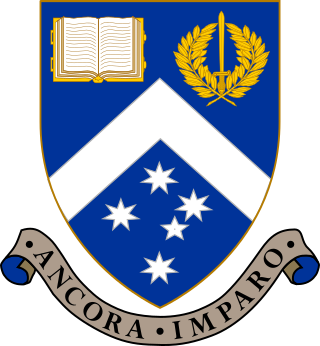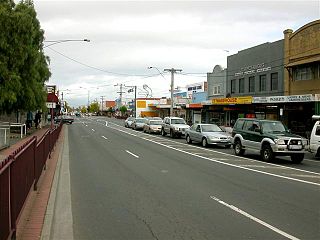
Monash University is a public research university based in Melbourne, Victoria, Australia. Named after prominent World War I general Sir John Monash, it was founded in 1958 and is the second oldest university in the state. The university has a number of campuses, four of which are in Victoria, one in Malaysia and another one in Indonesia. Monash also has a research and teaching centre in Prato, Italy, a graduate research school in Mumbai, India and graduate schools in Suzhou, China and Tangerang, Indonesia. Monash University courses are also delivered at other locations, including South Africa.

La Trobe University is a public research university based in Melbourne, Victoria, Australia. Its main campus is located in the suburb of Bundoora. The university was established in 1964, becoming the third university in the state of Victoria and the twelfth university in Australia. La Trobe is one of the Australian verdant universities and also part of the Innovative Research Universities group.

Parkville is an inner-city suburb in Melbourne, Victoria, Australia, 3 km (1.9 mi) north of Melbourne's Central Business District, located within the Cities of Melbourne and Merri-bek local government areas. Parkville recorded a population of 7,074 at the 2021 census.

Clayton is a suburb in Melbourne, Victoria, Australia, 19 km south-east of Melbourne's Central Business District, located within the City of Monash local government area. Clayton recorded a population of 18,988 at the 2021 census.

Scotch College is a private, Presbyterian day and boarding school for boys, located in Hawthorn, an inner-eastern suburb of Melbourne, Victoria, Australia.
The purpose of the Monash University Faculty of Arts is 'the pursuit, advancement and application of knowledge in the humanities, social and environmental sciences and creative and performing arts'. It offers degrees from undergraduate to PhD level. Entrance into the undergraduate Bachelor of Arts program is competitive, as it is the most popular Arts degree among university applicants in Victoria.

The Peter MacCallum Cancer Centre, also known as the Peter MacCallum Cancer Institute and commonly abbreviated as Peter Mac, is an Australian oncology research institute, cancer treatment and professional oncologist training centre located in Melbourne, Victoria. The centre is named in honour of Sir Peter MacCallum. Since June 2016, the centre has been located within the Victorian Comprehensive Cancer Centre (VCCC) in Parkville.

Monash University, Parkville campus is a campus of Monash University, located in Parkville, Victoria, Australia. It is home to the Faculty of Pharmacy and Pharmaceutical Sciences. Founded in 1881 and previously known as the Victorian College of Pharmacy, the faculty is the oldest school of pharmacy in Australia. A major centre of research and teaching, it is internationally regarded for its research in drug target biology and discovery, medicinal chemistry, drug development, formulation science, and medicine use and safety, including the discovery and development of the world's first successful anti-influenza drug, Relenza. In international rankings, it is ranked as the number one school of pharmacy and pharmacology in Australia and number two worldwide.

Monash University, Caulfield campus is a campus of Monash University located in Caulfield East, which is a suburb of Melbourne, Australia, in the state of Victoria. The campus comprises 13,400 students of which 52.8% are female and 57.1% of students are enrolled in undergraduate courses. Before its incorporation into Monash University, it was the Caulfield campus of Chisholm Institute of Technology, which was created from the union of Caulfield Institute of Technology and the State College of Victoria at Frankston.
Monash University Faculty of Law, or Monash Law School, is the law school of Monash University. Founded in 1963, it is based in Melbourne, Victoria and has campuses in Malaysia and Italy. It is consistently ranked as one of the top law schools in Australia and globally, and entry to its Bachelor of Laws (LLB) programme is highly competitive.

Monash University, Clayton campus is the main campus of Monash University located in Clayton, which is a suburb of Melbourne, Australia, in the state of Victoria.
The Australian Regenerative Medicine Institute (ARMI) is an Australian medical research institute. Opened in April 2009, the institute is based at the Clayton campus of Monash University, in the Monash Science Technology Research and Innovation Precinct.
The Monash Science Technology Research and Innovation Precinct (STRIP) is a cluster of commercial and university enterprises and research centres based at Monash University's Clayton Campus. The STRIP was officially opened on 18 February 2010 by Nobel laureate Professor Elizabeth Blackburn.
Sir James Adam Louis Matheson KBE CMG was a British engineer and university administrator, who served as the first Vice-Chancellor of Monash University in Melbourne, Australia.
The Monash Institute of Medical Research (MIMR), was an Australian medical research institute located in the Melbourne suburb of Clayton, Victoria, consisting of 400 scientists and students belonging to the Faculty of Medicine, Nursing and Health Sciences at Monash University. In January 2014 the Institute merged with Prince Henry's Institute of Medical Research and has since been renamed the Hudson Institute of Medical Research.
Sir Robert Rutherford Blackwood was an Australian engineer, prominent businessman and university administrator. He was the first chancellor of Monash University, serving from 1961 to 1968, and chairman of Dunlop Australia from 1972 to 1979.
MonashHeart is a non-profit cross-site cardiological service operating within the southern region of Victoria's Metropolitan Health Services.

The John Medley Building is at Kernot Road, The University of Melbourne, Parkville Campus, Melbourne, Victoria, Australia. The building was designed by Sir Roy Burman Grounds. It was constructed between 1969 and 1971, and was built to relieve the cramped conditions of the campus Old Arts Building, which was built from 1919 to 1924, and to house the larger departments of the university's faculty office.
Elizabeth Moulton Eggleston was an Australian activist, author, lawyer and champion for Indigenous Australians. She was described as a "gentle and unassuming" woman.

Simon Marginson is an Australian academic who researches higher education. He held professorships in education or higher education at Monash University (2000–06) and the University of Melbourne (2006–13) before moving to the United Kingdom as professor of international higher education at University College London (2013–18). As of 2021, he is the director of the ESRC/OFSRE Centre for Global Higher Education and professor of higher education at the University of Oxford.










